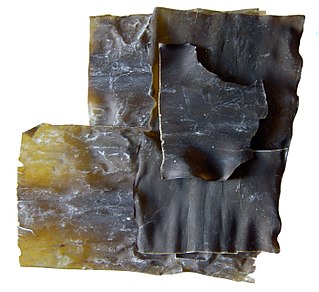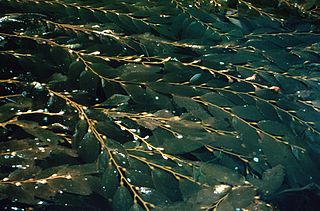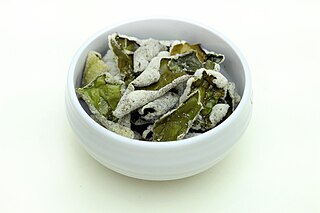
Kelps are large brown algae or seaweeds that make up the order Laminariales. There are about 30 different genera. Despite its appearance, kelp is not a plant but a stramenopile, a group containing many protists.

Brown algae are a large group of multicellular algae comprising the class Phaeophyceae. They include many seaweeds located in colder waters of the Northern Hemisphere. Brown algae are the major seaweeds of the temperate and polar regions. Many brown algae, such as members of the order Fucales, commonly grow along rocky seashores. Most brown algae live in marine environments, where they play an important role both as food and as a potential habitat. For instance, Macrocystis, a kelp of the order Laminariales, may reach 60 m (200 ft) in length and forms prominent underwater kelp forests that contain a high level of biodiversity. Another example is Sargassum, which creates unique floating mats of seaweed in the tropical waters of the Sargasso Sea that serve as the habitats for many species. Some members of the class, such as kelps, are used by humans as food.

Konbu is edible kelp mostly from the family Laminariaceae and is widely eaten in East Asia. It may also be referred to as dasima or haidai.

Wakame(Undaria pinnatifida) is a species of kelp native to cold, temperate coasts of the northwest Pacific Ocean. As an edible seaweed, it has a subtly sweet, but distinctive and strong flavour and texture. It is most often served in soups and salads.

Alaria esculenta is an edible seaweed, also known as dabberlocks or badderlocks, or winged kelp, and occasionally as Atlantic Wakame. It is a traditional food along the coasts of the far north Atlantic Ocean. It may be eaten fresh or cooked in Greenland, Iceland, Scotland and Ireland. It is the only one of twelve species of Alaria to occur in both Ireland and in Great Britain.

Laminaria is a genus of brown seaweed in the order Laminariales (kelp), comprising 31 species native to the north Atlantic and northern Pacific Oceans. This economically important genus is characterized by long, leathery laminae and relatively large size. Some species are called Devil's apron, due to their shape, or sea colander, due to the perforations present on the lamina. Others are referred to as tangle. Laminaria form a habitat for many fish and invertebrates.

Alginic acid, also called algin, is a naturally occurring, edible polysaccharide found in brown algae. It is hydrophilic and forms a viscous gum when hydrated. With metals such as sodium and calcium, its salts are known as alginates. Its colour ranges from white to yellowish-brown. It is sold in filamentous, granular, or powdered forms.

Macrocystis is a monospecific genus of kelp with all species now synonymous with Macrocystis pyrifera. It is commonly known as giant kelp or bladder kelp. This genus contains the largest of all the Phaeophyceae or brown algae. Macrocystis has pneumatocysts at the base of its blades. Sporophytes are perennial and the individual may live for up to three years; stipes/fronds within a whole individual undergo senescence, where each frond may persist for approximately 100 days. The genus is found widely in subtropical, temperate, and sub-Antarctic oceans of the Southern Hemisphere and in the northeast Pacific from Baja California to Sitka, Alaska. Macrocystis is often a major component of temperate kelp forests.

Arame, sea oak is a species of kelp, of the brown algae, best known for its use in Japanese cuisine.

Saccharina is a genus of 24 species of Phaeophyceae. It is found in the north Atlantic Ocean and the northern Pacific Ocean at depths from 8 m to 30 m.

Alaria is a genus of brown alga (Phaeophyceae) comprising approximately 17 species. Members of the genus are dried and eaten as a food in Western Europe, China, Korea, Japan, and South America. Distribution of the genus is a marker for climate change, as it relates to oceanic temperatures.

Bugak (부각) is a variety of vegetarian twigim in Korean cuisine. It is made by deep frying dried vegetables or seaweed coated with chapssal-pul and then drying them again. It is eaten as banchan or anju. Common ingredients are green chili peppers, perilla leaves, perilla inflorescence, camellia leaves, chrysanthemum leaves, burdock leaves, tree of heaven shoots, potatoes, gim (laver), and dasima (kelp). Vegetable oils such as perilla oil or soybean oil are typically used for frying.

Seaweed, or macroalgae, refers to thousands of species of macroscopic, multicellular, marine algae. The term includes some types of Rhodophyta (red), Phaeophyta (brown) and Chlorophyta (green) macroalgae. Seaweed species such as kelps provide essential nursery habitat for fisheries and other marine species and thus protect food sources; other species, such as planktonic algae, play a vital role in capturing carbon and producing at least 50% of Earth's oxygen.

Saccharina latissima is a brown alga, of the family Laminariaceae. It is known by the common names sugar kelp, sea belt, and Devil's apron, and is one of the species known to Japanese cuisine as kombu. It is found in the north Atlantic Ocean, Arctic Ocean and north Pacific Ocean. It is common along the coast of Northern Europe as far south as Galicia Spain, the coast of North America north of Massachusetts and central California, and the coast of Asia south to Korea and Japan.

Edible seaweed, or sea vegetables, are seaweeds that can be eaten and used for culinary purposes. They typically contain high amounts of fiber. They may belong to one of several groups of multicellular algae: the red algae, green algae, and brown algae. Seaweeds are also harvested or cultivated for the extraction of polysaccharides such as alginate, agar and carrageenan, gelatinous substances collectively known as hydrocolloids or phycocolloids. Hydrocolloids have attained commercial significance, especially in food production as food additives. The food industry exploits the gelling, water-retention, emulsifying and other physical properties of these hydrocolloids.

Laminaria hyperborea is a species of large brown alga, a kelp in the family Laminariaceae, also known by the common names of tangle and cuvie. It is found in the sublittoral zone of the northern Atlantic Ocean. A variety, Laminaria hyperborea f. cucullata is known from more wave sheltered areas in Scandinavia.

Aquaculture of giant kelp, Macrocystis pyrifera, is the cultivation of kelp for uses such as food, dietary supplements or potash. Giant kelp contains iodine, potassium, other minerals vitamins and carbohydrates.
Saccharina dentigera is a species of brown algae, in the family Laminariaceae. It is native to shallow water in the northeastern Pacific Ocean from the Gulf of Alaska to Baja California.

Laminaria nigripes is a species of kelp found in the North Atlantic and North Pacific within Arctic and subarctic waters including Vancouver Island, Haida Gawaii, Greenland, Iceland, Norway, Downeast Maine, and the Bay of Fundy. The species may be found exclusively in the Arctic, but frequent misidentification of samples has led to speculation and debate over whether the actual range is subarctic or Arctic. The species is commonly confused with Laminaria digitata and Laminaria hyperborea and is at risk from climate change.
Kjellmaniella is a monotypic genus of kelp comprising the species Kjellmaniella crassifolia, known as gagome (ガゴメ/籠目) in Japanese.






















